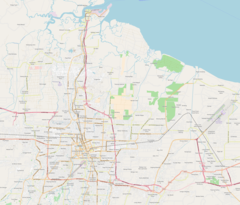
Medan is the capital and largest city of the Indonesian province of North Sumatra. The nearby Strait of Malacca, Port of Belawan, and Kualanamu International Airport make Medan a regional hub and multicultural metropolis, acting as a financial centre for Sumatra and a gateway to the western part of Indonesia. About 60% of the economy in North Sumatra is backed by trading, agriculture, and processing industries, including exports from its 4 million acres of palm oil plantations. The National Development Planning Agency listed Medan as one of the four main central cities in Indonesia, alongside Jakarta, Surabaya, and Makassar.

The Sultanate of Serdang was an early modern Malay-Indonesian monarchy, Serdang was founded in 1723 and joined the Republic of Indonesia in 1946. The Sultanate separated from the Sultanate of Deli after a dispute over the royal throne in 1720. Like other kingdoms on the east coast of Sumatra, Serdang prospered due to the opening of tobacco, rubber and oil palm plantations.

Maimoon Palace or Maimun Palace is an istana of the Sultanate of Deli and a well-known landmark in Medan, the capital city of Northern Sumatra, Indonesia. Today, it serves as a museum. The name is the Arabic word for "blessing".
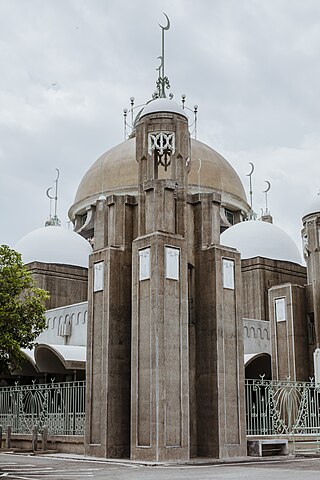
Sultan Sulaiman Royal Mosque is Selangor's royal mosque, which is located in Klang, Selangor, Malaysia. It was constructed by the British in the early 1932 and was officially opened in 1933 by the late Almarhum Sultan Sir Alaeddin Sulaiman Shah.

The Sultan Salahuddin Abdul Aziz Shah Mosque is the state mosque of Selangor, Malaysia. It is located in Shah Alam and is the country's largest mosque and also the second largest mosque in Southeast Asia by capacity. Its most distinguishing feature is its large blue and silver dome. The mosque has four minarets, one erected at each of the corners.

The Abidin Mosque is Terengganu's old state royal mosque built by Sultan Zainal Abidin II between 1793 and 1808. The mosque, which is also known as the White Mosque or the Big Mosque, is located in Kuala Terengganu, Terengganu, Malaysia. The old Royal Mausoleum is situated near the mosque.

The Sultanate of Deli was a 1,820 km² Malay state in east Sumatra founded in 1630. A tributary kingdom from 1630 it was controlled by various Sultanates until 1814, when it became an independent sultanate and broke away from the Sultanate of Siak.
The architecture of Kuala Lumpur is a blend of old colonial influences, Asian traditions, Malay Islamic inspirations, modern and post modern mix. Being a relatively young city, most of Kuala Lumpur's colonial buildings were built toward the end of 19th and early 20th century. These buildings have Mughal, Tudor, Neo-Gothic or Grecian-Spanish style or architecture. Most of the styling have been modified to cater to use local resources and the acclimatized to the local climate, which is hot and humid all year around.

The Sultanate of Langkat was a Malay Muslim state located in modern Langkat Regency, North Sumatra. It predates Islam in the region, but no historical records before the 17th century survive. It prospered with the opening of rubber plantations and the discovery of oil in Pangkalan Brandan.

Tjong A Fie, Majoor der Chinezen (1860–1921), or Tjong Yiauw Hian, birth name Zhang Hongnan, was a Hakka Chinese businessman, banker and kapitan who built a large plantation business in Sumatra, Indonesia. Tjong A Fie built his business that employed more than 10,000 labor workers. Because of his great success, he maintained a good relationship with the ruler of Deli, including the ninth Sultan of Deli, Sultan Ma'mun Al Rashid Perkasa Alamyah and Dutch authorities.
Malaysia practises an elective monarchy, so there is no distinct line of succession to the Malaysian thrones. In the event where the current seat of the throne falls vacant, the Conference of Rulers meet to elect the new Yang di-Pertuan Agong (monarch) from among the rulers of the nine Malay states. The deputy king does not automatically succeed the throne. The election is regulated by Article 32 of the Constitution of Malaysia.
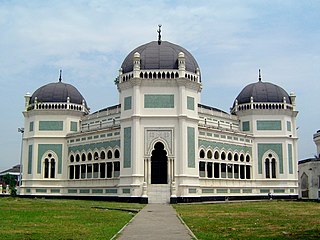
Grand Mosque of Medan or Masjid Raya Al-Mashun is a mosque located in Medan, Indonesia. The mosque was built in the year 1906 and completed in 1909. In beginning of its establishment, the mosque was a part of the Maimun palace complex. Its architectural style combines Middle Eastern, Indian and Spanish elements. The mosque has an octagonal shape and has wings to the south, east, north and west.
Dato' Y. T. Lee, also Lee Yoon Thim was a Malaysian Chinese architect active in Kuala Lumpur in the 1950s and 1960s. He helped "Build Merdeka" after Malaysian Independence, 1963. He moved in elite circles, and held several positions in the national government and in the Chinese community. He was a close friend to Prime Minister Tuanku Abdul Rahman and other political figures. He designed several of Kuala Lumpur's landmark buildings, such as: Chin Woo Stadium, UMNO building, Dewan Bahasa dan Pustaka, Federal Hotel, Kampung Baru Mosque, Ar-Rahman Mosque and the Masjid Al-Ubudiyah. In addition to his famous mosques in Kuala Lumpur, he also worked on middle eastern and Islamic architecture project, for example, Masjid Al- Ubudiyah in Kerling, Hulu Selangor which is opened in 1960. When this masjid is built, there was no electricity supply yet. Somehow now it has been used as a teaching place by the locals. His less well known works include the Too House, an addition for the Methodist Boys School, and healthcare-related and commercial work. In the early 1960s, a series of honours came his way: in 1960, he was granted the appellation of P.J.K.; in 1961, he was honoured as Justice of Peace and J.M.N in 1962; he was honoured as Dato' in 1964, an honorific similar to the British "Sir".
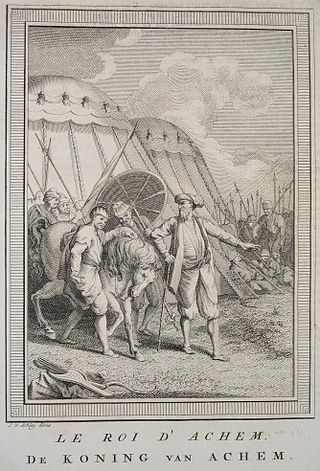
Sultan Alauddin Johan Syah was the twenty-fourth sultan of Aceh in northern Sumatra. He represented the second generation of the Bugis dynasty of Aceh and ruled from 1735 to 1760.
Sultan Alauddin Mahmud Syah I was the twenty-fifth sultan of Aceh in northern Sumatra. He ruled from 1760 to 1781, although his reign was twice interrupted by usurpers.

Sultan Ma'mun Al Rashid Perkasa Alam Shah was the 9th king of the Sultanate of Deli. His title after his death was Marhum Makmur.

Jamek Mosque, officially Sultan Abdul Samad Jamek Mosque is one of the oldest mosques in Kuala Lumpur, Malaysia. It is located at the confluence of the Klang and Gombak River and may be accessed via Jalan Tun Perak. The mosque was designed by Arthur Benison Hubback, and built in 1909.
Tuanku Sri Paduka Gocah Pahlawan also known as Muhammad Dalik according to Hikayat Deli, was the founder of the Sultanate of Deli and the Sultanate of Serdang in North Sumatra, Indonesia. According to the tarombo from Deli and Serdang, Gocah Pahlawan was of keling (Indian) ethnicity, sent by Sultan Iskandar Muda in 1612 to rule in the former Aru Kingdom. He was appointed as a representative commander of the Aceh Sultanate for the area, to fight the Portuguese influence and establish alliances with the local population, who generally were Karo peoples.
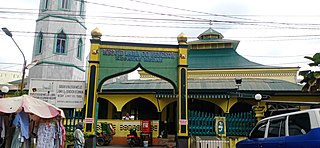
Gang Bengkok Old Mosque, is a mosque located in Medan, North Sumatra, Indonesia. The Gang Bengkok Old Mosque is precisely located on Jalan Mesjid, Kesawan, West Medan Districy, Medan. Gang Bengkok Old Mosque was built by a merchant and Kapitan from Guangdong, China, named Tjong A Fie. This mosque was first built in 1885, but the renovation was completed in 1889. This mosque was then handed over by Tjong A Fie to the Deli Sultanate, namely during the reign of Sultan Deli Sultan Ma'mun Al Rashid.

Bachtiar Djafar was an Indonesian military officer and politician who served as the mayor of Medan, North Sumatra between 1990 and 2000.


